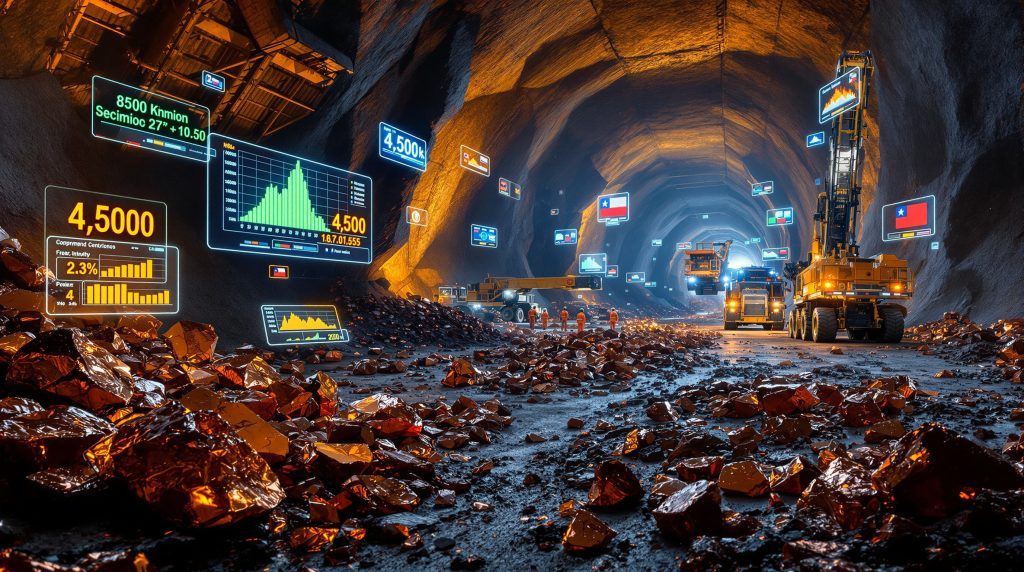The Fatal Incident That Shook Chile's Mining Industry
Chile's copper mining sector experienced a devastating workplace tragedy in July 2025 when six subcontract workers perished in a tunnel collapse at Codelco's El Teniente copper mine. The Codelco El Teniente copper mine accident occurred within the mine's Andesita section, a component of an intricate underground network spanning 4,500 kilometers that positions El Teniente among the world's most complex mining operations.
The state-owned mining giant, which serves as the globe's largest copper producer, faced immediate operational disruptions following the accident. This tragedy highlighted the inherent dangers of deep underground mining operations and sparked renewed discussions about safety protocols in Chile's mining industry evolution.
El Teniente, operating continuously since 1905, represents Codelco's most profitable mining operation and stands as one of the oldest continuously functioning mines globally. The facility has produced over 30 million metric tons of copper throughout its operational lifetime, making this accident particularly significant for both the company and Chile's broader economy.
Understanding the El Teniente Mine Collapse
Emergency Response and Recovery Operations
Following the tunnel collapse, Codelco mobilised extensive resources for recovery operations. The company deployed specialised personnel and advanced machinery in a comprehensive two-day search and recovery mission. Despite these efforts, all six missing workers were ultimately recovered without survivors.
The immediate impact forced Codelco to suspend operations indefinitely in the affected Andesita unit pending completion of a thorough safety investigation. This operational halt was expected to continue until investigators could determine the root cause and implement necessary safety measures.
Technical Analysis of the Incident
According to Codelco Chairman Maximo Pacheco, preliminary investigations identified the most probable cause as a rock burst phenomenon. This geological event resulted from several interconnected factors:
- Structural modifications: Changes in the deposit's natural geological formation
- Vertical stress patterns: Geometric alterations creating dangerous cavity interactions
- Material instability: Northwest deposit area experiencing weakened structural integrity
- Deep rock layer dynamics: Underground formations shifting against each other at depth
Rock bursts represent one of the most dangerous hazards in deep underground mining. These events occur when accumulated stress in rock formations suddenly releases energy, causing violent and often unpredictable rock ejections. Furthermore, the phenomenon becomes increasingly common in deeper mining operations where high stress concentrations naturally develop.
According to mining safety research, rock bursts remain responsible for approximately 15-20% of underground mining fatalities in hard-rock mining operations globally between 2010 and 2020.
Production Impact and Market Consequences
Revised Loss Estimates
The accident's impact on Codelco's production proved more severe than initially anticipated. The company revised its production loss estimates significantly upward, demonstrating the complexity of assessing operational disruptions in large-scale mining operations.
| Impact Metric | Revised Estimate | Financial Consequence |
|---|---|---|
| Copper Output Loss | 48,000 metric tons | 45% higher than initial projections |
| EBITDA Impact | $500 million | Substantial earnings reduction |
| Unit Status | Indefinitely suspended | Pending investigation completion |
Market Response and Pricing
The production shortfall at El Teniente, combined with disruptions at other major global operations including Freeport-McMoRan's Grasberg mine in Indonesia, contributed to significant copper price increases. Market prices reached $11,000 per metric ton, approaching record levels established in the previous year.
This price movement reflected the tight global copper supply situation and highlighted the market's sensitivity to production disruptions at major mining operations. In addition, the timing proved particularly significant given increasing global demand for copper in renewable energy infrastructure and electric vehicle production, leading to surging copper investments.
Geological Factors and Rock Burst Analysis
Understanding Rock Burst Mechanisms
Rock bursts occur through a complex process involving multiple geological and operational factors. In El Teniente's case, the phenomenon appeared linked to specific conditions within the mine's northwest deposit area:
Stress Concentration Factors:
- Mining-induced stress redistribution
- Natural geological fault systems
- Deep excavation effects on rock stability
- Cavity interaction between different mining areas
Geological Context:
The Andes Mountain range, where El Teniente operates, features complex geological structures including active tectonic activity. Chile's location along the Pacific Ring of Fire creates additional considerations for deep underground mining stability.
The mine operates at significant depths within these challenging geological conditions, requiring sophisticated monitoring and support systems to maintain operational safety. Consequently, the 4,500-kilometre tunnel network represents an engineering achievement while simultaneously creating complex stress patterns throughout the underground workings.
Enhanced Safety Monitoring Implementation
Comprehensive Monitoring Systems
Following the Codelco El Teniente copper mine accident, Codelco announced plans to implement enhanced monitoring capabilities throughout the entire El Teniente complex. These systems will provide real-time assessment of multiple geological and operational parameters:
Monitoring Components:
- Terrain structure analysis: Continuous geological formation assessment
- Seismic activity tracking: Advanced detection systems for ground movement
- Geomechanical monitoring: Real-time stress and stability measurements
- Network-wide surveillance: Coverage across all 4,500 kilometres of tunnels
Technology Integration and Automation
The accident accelerated Codelco's automation initiatives designed to minimise human exposure to high-risk underground environments. These technological advances represent a strategic shift toward remote-controlled operations in dangerous mining areas, incorporating AI in mining operations.
Automation Priorities:
- Remote-controlled mining equipment deployment
- Autonomous systems for hazardous operations
- Advanced warning systems for geological events
- Reduced personnel requirements in high-risk zones
Leading underground mining operations globally employ multi-parameter monitoring systems that integrate microseismic monitoring networks, ground deformation measurement systems, and real-time data analysis platforms. For instance, these technologies can provide warning times ranging from minutes to hours before major seismic events, though rock bursts can still occur with minimal advance warning.
Codelco's 2025 Performance Outlook
Production Resilience Despite Setbacks
Despite the significant disruption at El Teniente, Chairman Pacheco maintained optimistic projections for Codelco's overall 2025 performance. The company's diversified operations across multiple mining complexes provided operational resilience against single-site disruptions.
Performance Metrics:
- January-September production: 938,000 tons (2% increase year-over-year)
- Annual guidance range: 1.34 million to 1.37 million tons
- Expected outcome: Slight increase over 2024 levels despite El Teniente losses
Strategic Development Initiatives
Codelco continues advancing several major strategic initiatives that will shape its long-term operational capacity through modern mine planning:
Andina-Los Bronces Joint Operation:
- Environmental permit applications targeted for 2027
- Partnership between Codelco's Andina mine and Anglo American's Los Bronces operation
- Agreement finalised in September 2025
- Projected savings of $5 billion over operational lifetime
Quebrada Blanca Involvement:
- 10% ownership stake providing strategic positioning
- Two board seats ensuring operational input
- Teck Resources maintains operational control
- Potential integration with adjacent Collahuasi mine under proposed Anglo American merger
Global Copper Supply Chain Implications
El Teniente's Strategic Importance
El Teniente's significance extends beyond Codelco's operations to global copper supply chains. However, the mine's position as one of the world's largest underground copper producers makes production disruptions particularly impactful for international markets.
Mine Specifications:
- Global ranking: Among the world's largest underground copper operations
- Infrastructure complexity: 4,500-kilometre tunnel network
- Profitability: Codelco's most profitable mining operation
- Strategic value: Critical component of Chile's position as world's leading copper producer
Market Demand Drivers
The copper supply disruption occurred amid increasing global demand driven by energy transition initiatives:
Electric Vehicle Requirements:
Battery electric vehicles contain approximately 83 kilograms of copper compared to 23 kilograms in internal combustion engine vehicles, representing a 260% increase in copper intensity per vehicle.
Renewable Energy Systems:
Different renewable energy technologies require varying copper intensities:
- Solar photovoltaic systems: 5.5 tons per megawatt
- Onshore wind installations: 3.5 tons per megawatt
- Offshore wind developments: 8.0 tons per megawatt
The International Energy Agency projects that copper demand for clean energy technologies will increase from approximately 5 million tons in 2023 to over 10 million tons by 2030, highlighting the critical importance of maintaining stable production levels.
Industry-Wide Safety Lessons
Mining Safety Protocol Evolution
The Codelco El Teniente copper mine accident underscored critical areas requiring industry-wide attention for enhanced underground mining safety:
Essential Safety Improvements:
- Advanced geological monitoring systems with predictive capabilities
- Enhanced personal protective equipment for underground workers
- Improved emergency response protocols and rapid deployment capabilities
- Comprehensive risk assessment procedures for deep mining operations
Global Mining Industry Response
Mining companies worldwide reassessed their deep underground operations following the incident, particularly focusing on:
- Rock burst prediction and prevention methodologies
- Automated systems reducing human exposure to geological hazards
- Enhanced geological surveying before tunnel development
- Standardised emergency response protocols across operations
The incident served as a reminder that despite technological advances, deep underground mining continues to present significant challenges requiring continuous innovation in safety systems and operational procedures.
Regulatory Environment and Compliance
Chilean Mining Safety Framework
Chile operates under comprehensive mining safety regulations administered by Sernageomin (National Geology and Mining Service). All mining operations must comply with Supreme Decree No. 132, which establishes mandatory safety standards including incident reporting and investigation protocols.
Regulatory Requirements:
- Mandatory incident reporting within specified timeframes
- Independent investigation procedures for serious accidents
- Safety system compliance verification
- Regular inspection and audit protocols
Economic Impact on Chile
The mining sector's importance to Chile's economy amplifies the significance of safety incidents like the Codelco El Teniente copper mine accident:
Economic Dependency Metrics:
- Copper exports: 15% of Chile's GDP (2024)
- Export contribution: Over 50% of total national exports
- Direct employment: 250,000 workers in mining sector
- Indirect employment: 500,000 additional jobs through contracting and services
According to Chile's National Statistics Institute, the mining sector's employment impact extends far beyond direct mining operations, supporting substantial secondary economic activity throughout the country.
Investigation Timeline and Operational Recovery
Current Investigation Status
The comprehensive investigation into the El Teniente accident follows established protocols for major mining incidents. Codelco expects to complete its internal investigation by the end of 2025, with findings informing future safety protocols and operational procedures.
Investigation Components:
- Forensic analysis of the accident site
- Geological and geotechnical assessment
- Review of safety procedures and compliance
- Equipment and systems evaluation
Recovery and Resumption Planning
The path to operational resumption at the Andesita unit depends on investigation findings and implementation of enhanced safety measures:
Recovery Phases:
- Investigation completion: Determining root cause and contributing factors
- Safety system upgrades: Implementing enhanced monitoring and protection systems
- Gradual resumption: Phased return to operations with upgraded protocols
- Full operational restoration: Complete integration of new safety technologies
The timeline for each phase remains dependent on investigation outcomes and successful implementation of required safety enhancements. However, Codelco's commitment to preventing similar incidents takes precedence over production timeline pressures.
Future Implications for Deep Underground Mining
Technology Integration Acceleration
The El Teniente accident highlighted the urgent need for accelerated technology integration in deep underground mining operations. Industry leaders recognise that traditional mining approaches require substantial enhancement to address evolving geological challenges.
Technological Priorities:
- Real-time geological hazard detection systems
- Autonomous equipment reducing human exposure
- Predictive analytics for rock stability assessment
- Enhanced communication systems for emergency response
Long-term Industry Evolution
The incident represents a catalyst for broader industry evolution toward safer, more technologically advanced underground mining operations. This transformation requires significant investment in research, development, and implementation of innovative safety technologies.
Mining companies globally are reassessing their approach to deep underground operations, balancing production efficiency with enhanced safety requirements. Consequently, the lessons learned from El Teniente will likely influence industry standards and regulatory requirements for years to come.
This analysis is based on publicly available information and industry sources. Mining operations involve inherent risks, and safety conditions can change rapidly. Investors and stakeholders should consult current reports and expert analysis when making decisions related to mining investments or operations.
Ready to Capitalise on Major Mining Developments and Market Opportunities?
Discovery Alert's proprietary Discovery IQ model delivers real-time alerts on significant ASX mineral discoveries, turning complex mining data into actionable insights for savvy investors. Whether you're tracking market-moving events like production disruptions or seeking emerging exploration opportunities, begin your 30-day free trial today to secure your competitive advantage in the dynamic mining sector.




